Northwest Native Arts Basic Forms Authentic Northwest Native Art Orca
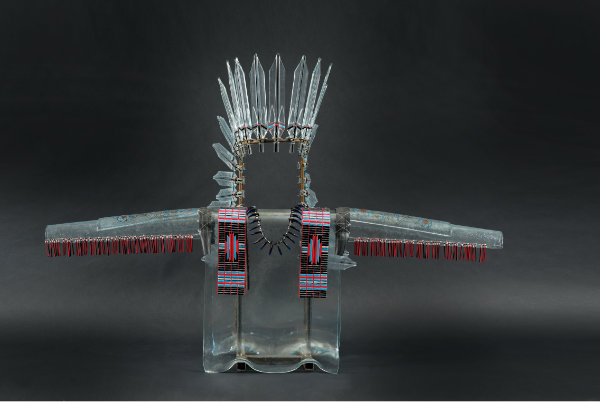 Rory Erler Wakemup (Minnesota Chippewa), Ghost Shirt, 2014. Glass and rebar. 34 ½ × 51 ½ × 18 in. Accession/catalog no. CHP-187, collection of the IAIA Museum of Contemporary Native Arts. Photo by Eric Wimmer. Courtesy the IAIA Museum of Contemporary Native Arts.
Rory Erler Wakemup (Minnesota Chippewa), Ghost Shirt, 2014. Glass and rebar. 34 ½ × 51 ½ × 18 in. Accession/catalog no. CHP-187, collection of the IAIA Museum of Contemporary Native Arts. Photo by Eric Wimmer. Courtesy the IAIA Museum of Contemporary Native Arts.
By Dr. Letitia Chambers
Clearly Indigenous: Native Visions Reimagined in Glass is a groundbreaking exhibition of works in glass past Ethnic artists. Co-curated by Dr. Letitia Chambers and Cathy Short (Denizen Potawatomi) and on view at the Museum of Indian Arts and Culture in Santa Fe through June 22, 2022, the stunning art in the exhibit embodies the intellectual content of Native traditions expressed in glass. A companion book of the aforementioned name (Museum of New Mexico Press, 2021) tells the story of how glass fine art came to Indian Country and provides information on the American Indian artists who piece of work in the medium of glass and the processes and methods they employ in creating glass art.
Story Tellers in Glass: An Showroom Overview
The exhibition presents glass fine art made by twenty-nine Native artists from twenty-half dozen tribes from the U.S. and Canada, also as artworks past Dale Chihuly, who founded several didactics programs where Native American students learned the art of working with glass. Native American glass artists have also collaborated with Indigenous artists from Pacific Rim countries, and glass creations past ii Māori artists from New Zealand and two Aboriginal Australian artists are also included in the exhibit and the book.
The stunning pieces of glass art in this exhibition certificate the fusion of the Contemporary Native Arts and the Studio Glass Art movements. This fusion forms a new genre of drinking glass art, characterized by the intellectual content of Native traditions and expressed using the properties that tin can exist achieved past working with drinking glass. While the book is organized around the artists, the exhibition is organized around the subject matter of the works of arts, highlighting the traditional iconography embodied in these works in the gimmicky medium of glass.
The artists and artworks featured here in El Palacio provide only a brief experience of the total showroom, which includes over 130 works of fine art. Images of only a few of the many fascinating works of fine art referenced in this text are pictured here.
Inspiration for Native drinking glass art has come from multiple sources. It may be tribal commonsensical items, such as vessels and baskets, or it may come up from a achieve dorsum into mythology, creation stories, ancient imagery, and oral history. It is often an estimation of cultural heritage, a way of honoring and giving voice to ancestors. Other works incorporate important cultural ways of knowing, such as respect for flora and animate being.
Native glass art may besides exist an expression of more contemporary issues affecting today's Native Americans and/or order at large. Some works in the exhibit include a political dimension that incorporates references to important stories in history or are a reaction to current events, while other pieces are notable for their advocacy role.
Pueblo Pottery Recreated in Glass
Tribal functional items, such equally ceramic pots or baskets woven from natural fibers, correspond artistic traditions even so followed past glass artists. Pueblo peoples of the southwestern United States have created commonsensical vessels made of clay for millennia. Historic pots and other vessels can be establish in museum collections and are admired not only for their utility, but also for their artistry. In the twentieth century and continuing to the nowadays, traditional pottery forms made by contemporary Pueblo potters accept been appreciated for both their dazzler and the cultural continuity they represent.
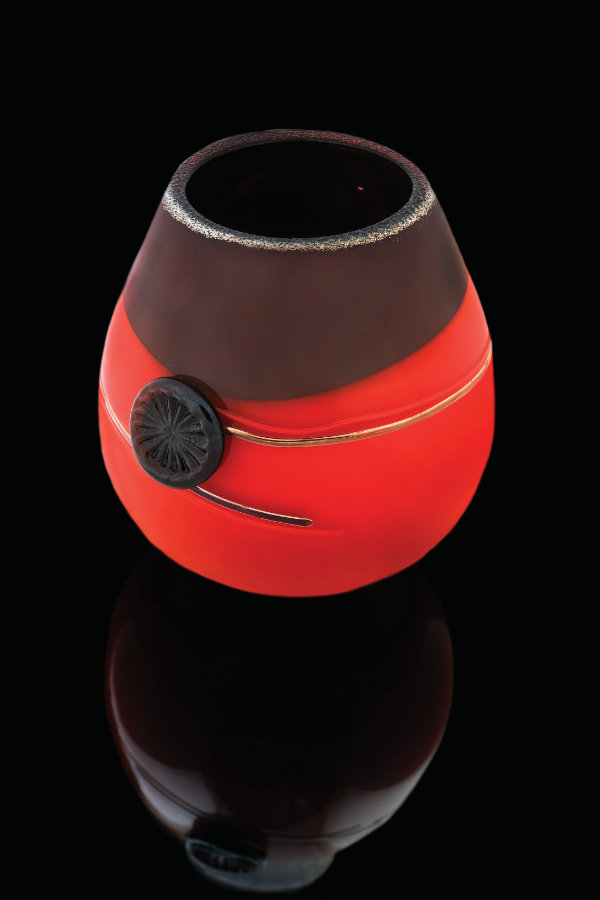
Tony Jojola (Isleta Pueblo), untitled, 2014. Diddled glass with argent stamps. eight 1/10 × 74/5 in. MIAC Collection: 59229. Photograph by Kitty Leaken. Courtesy the Museum of Indian Arts and Culture.
Several Pueblo artists take called to work in glass as their primary medium of creation. Tony Jojola (Isleta Pueblo), one of the first Native artists to piece of work in glass, finds inspiration in the Pueblo pottery with which he grew upward. While the forms he creates are rooted in tradition, he infuses his glass fine art with beautiful colors to create vivid, luminous vessels. Jojola inherited his granddaddy's jewelry-making tools and silver stamps, and he has used the stamp on some of his glass vessels.

The drinking glass vessels created by Robert "Spooner" Marcus (Ohkay Owingeh) are rooted in Pueblo tradition, and the striking range of colors and the light emanating through his pieces in the exhibit are particularly beautiful. Recently, Marcus started a series of vessels inspired past a book on a collection of ancestral Puebloan pottery. Many of the items in the collection were pieced together from shards, with the lines from their reassembly however visible, a look which Marcus has recreated in glass. To several of the vessels in this series, he added a ladder to represent Pueblo kiva entrance ladders. While Marcus oftentimes makes vessels, his love of experimentation has likewise led him to create sculptural forms, such as a articulate glass replica of a Pueblo on a granite base, with a ceramic pot set at the entrance.
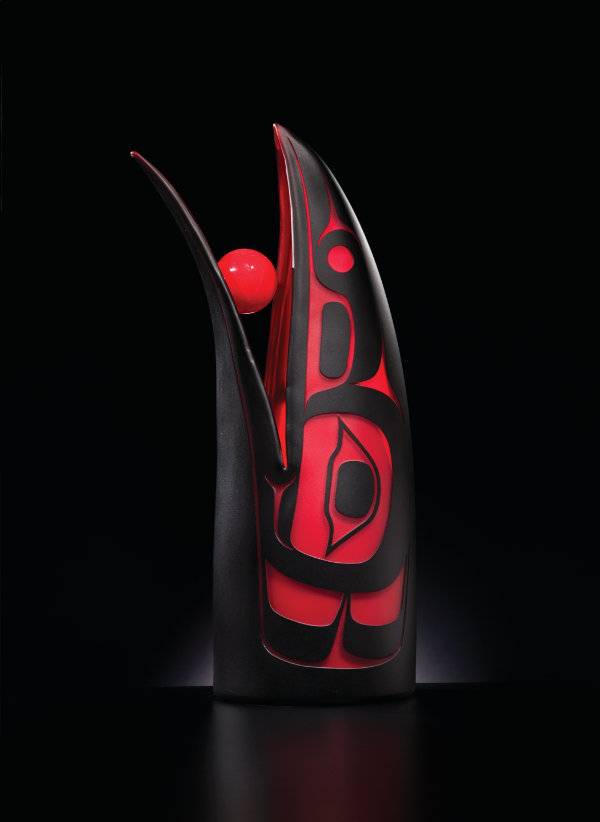
9 × twenty ¼ × seven in. Photograph by Russell Johnson. Courtesy Preston Singletary Studio.
Several notable Pueblo potters, who more often than not work with clay, have collaborated with Tlingit glass artist Preston Singletary to create works of art that incorporate Pueblo pottery designs onto blown glass vessels, including Tammy Garcia (Santa Clara), Jody Naranjo (Santa Clara) and Harlan Reano (Kewa Pueblo).
For example, Garcia began a collaboration in 2005 with Singletary to transform her pottery designs into glass. Using Garcia's designs, Singletary and his squad blew glass bowls, which Garcia then carved. These vessels are stunning in their representation of Santa Clara pottery, with the medium of glass adding a luminescence that enhances the visual touch on. Famous for making black pottery in the Santa Clara tradition, Garcia created a series of black pots in glass. Garcia and Singletary have worked together on several occasions, and other glass vessels from these collaborations demonstrate the depth of colour characteristic of glass.
Basketry of Northwest Declension Tribes Re-Envisioned in Glass
Tribal peoples of the North American Pacific Coast historically made utilitarian vessels of barks, grasses, or wood. Traditional baskets and bags were made of natural fibers later on a painstaking process of collecting and preparing the materials then that they could be woven into useful vessels. Artists from Salish, Tlingit, Lummi, and other Northwest Coast tribes have reinterpreted baskets and bags in blown and woven drinking glass.
Dan Friday's understanding of his Lummi culture was influenced by Lummi creative person Fran James, a primary basket weaver who worked with cedar, cerise bark, and bear grass. To accolade the importance of weaving in the Lummi tradition, Fri created a series of baskets woven in drinking glass, which he entitled Aunt Fran's Basket, in homage to James. To make his striking glass baskets, Friday groups glass rods of varying colors, and then he pulls them together into a packet, which he fuses with a torch. The bundle is placed in a furnace to create molten glass, which he then blows into a vessel. This creates the consequence of the crisscross of the traditional woven cedar baskets that inspired him.
Raya Friday (Lummi), like her brother Dan, also makes glass baskets, as does Haila Old Peter (Skokomish/Chehalis), a well-known handbasket weaver who in recent years has begun creating baskets in drinking glass that mirror her grass and cedar basket designs. Alano Edzerza (Tahltan) has carved stunning glass boxes. These and the other artists featured in this section of the exhibit have based their glass art on the baskets, bags and boxes made of natural fibers and wood in their tribal homelands in the Pacific Northwest.
Textiles Recreated in Drinking glass
Textiles have been woven in the Americas for over 12,000 years using natural constitute fibers and coats of animals. Traditional spindle whorls for making threads have been created in drinking glass by several artists, notably by Susan Point (Musqueam). In the southwestern United States, fabrics were historically woven of cotton and wool; Ballad Lujan (Navajo) has created glass panels, which incorporate woven designs such as those fabricated past her grandmother. These works reflect the importance of textile production in Native life.
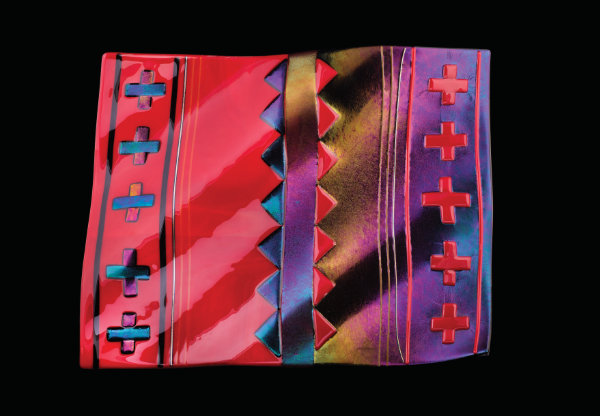
Gifts from the Sea
Native Americans have traditionally regarded all of nature as an integrated whole, and nature often plays an important role in tribal ceremonies and fine art. Legends and stories often involve animals of the state, sky, rivers, and oceans.
A major section of the showroom is devoted to the bounding main creatures that are and then important to the tribal peoples of the Northwest coast. Tlingit artist Raven Skyriver has created beautiful sea animals using an off-hand sculpture technique, and both the quality of the sculpture and the colors he creates are visually striking.
In that location are several renditions in the showroom of orcas, which are the largest member of the dolphin family. Orcas are of import in Native life and legends and are oftentimes depicted in the fine art of Northwest Declension tribes. The orca is said to protect those who travel away from dwelling house, and to assist lead them back. Orcas in the showroom have been created by several artists, including Skyriver, Singletary, and Marvin Oliver (Quinault/Isleta Pueblo).
H2o is ofttimes incorporated into art to express concern for the environment, especially the rising oceans. Rivers take played a pregnant role in the siting of settlements for tribes, and Brian Barber, a Pawnee architect and glass creative person, has created a site model in glass of the area of the Platte River adjacent to a Pawnee sacred site on the American plains. In that location likewise are a number of pieces in the showroom that represent the tools for trapping and catching fish for sustenance, historically an of import part of tribal life.
Animals of the Country
Respect for the creature world is a prominent cultural principle in Native communities. When animals are killed for food, the hunter thanks the creature and explains how its body will exist used. Animals may likewise provide spiritual guidance. Bears symbolize strength and courage, and wolves figure predominantly in legends where they generally signify protection. Numerous depictions of these and other totemic animals are included in the exhibit by such well known artists as Ed Archie NoiseCat (Salish/Shuswap), Ira Lujan (Taos Pueblo/Okhay Owingeh), and Dan Fri.
Fri'southward great-grandfathers were well known woods carvers, renowned for totem pole etching, as well every bit for being culture-bearers in their community. Creating totem poles in drinking glass became for Friday a way of continuing his family unit's traditions. The exhibit also includes the showtime known brute created in glass by a Native creative person: Scorpion (ca. 1978) past Larry Ahvakana (Inupiaq), who was the commencement Native creative person to work in glass, commencement at the Rhode Island School of Design in the early 1970s.
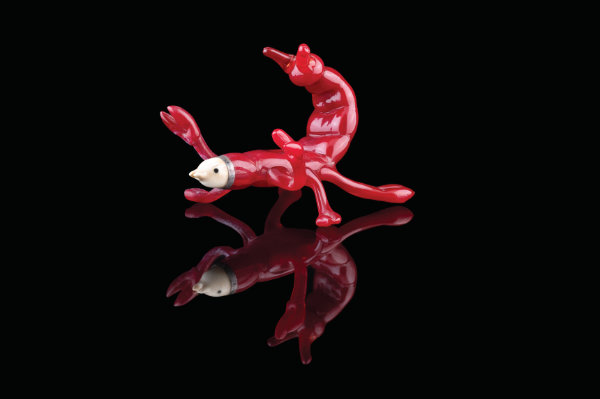
Courtesy the Museum of Indian Arts and Culture.
The Sky Above and Flying Creatures
Long before European contact, Ethnic tribes of the Americas had avant-garde knowledge of astronomical cycles, and depictions of the sun and stars were mutual. Made past many tribes, star maps reflected the heavens and also a philosophy of being. Weather condition-related aspects also appear in drawings, such equally depictions of clouds and lightning and other symbols of thunder and rain. Artists have reimagined such elements in blown and cast glass.
Ancestral Puebloan peoples incorporated this data about the sun and moon and the alignment of sunrises and sunsets during solstices and equinoxes into their architecture, as establish at the ruins of Chaco Canyon in New United mexican states. Works in the exhibit of several artists reverberate this knowledge of the heavens, including pieces by well-known sculptor and glass creative person Adrian Wall (Jemez Pueblo).
Birds and other flying creatures play primary roles in many Native myths and other stories. Eagles carry prayers to the Creator. Owls and other birds are featured in totems. Other flying creatures in the exhibit include Butterflies by Ramson Lomatewama (Hopi), Ballad Lujan's (Navajo) Dancing Dragonflies, Ira Lujan's (Taos/Ohkay Owingeh) Quail Canopic Jar, and Circumvoluted Ravens by Shawn Peterson (Puyallup). Several artists have as well depicted creatures equally decorations on vessels or baskets, combining the making of utilitarian objects with their respect for birds and other animals. The resulting works are notable for their artistry as well as for their cultural expression.
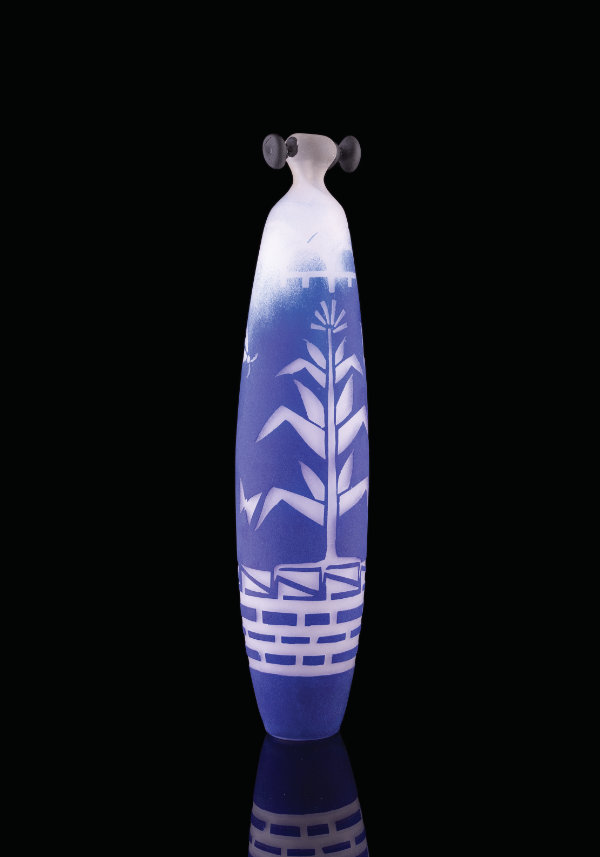
Courtesy the Museum of Indian Arts and Culture.
A major focus of Singletary's piece of work is the Tlingit creation story of Raven stealing the dominicus, the moon, and the stars and flinging them into the sky to give lite to the people. Singletary has get internationally recognized for the vivid combination of his talent for creating glass objects and his apply of the forms and symbology of his native Tlingit culture.
Interpreting Ancestors' Voices in Glass
Native glass artists have also drawn inspiration from their tribal mythology and oral histories, reinterpreting traditional stories or designs in drinking glass. Communications from the ancestors in the form of petroglyphs and pictographs also link current Native communities to the past. Drinking glass artists accept symbolized their ancestors through cast glass masks and other regalia, and through cast or diddled glass version of ancient pictographs. These works in glass are an estimation of cultural heritage and serve as ways of honoring and giving voice to ancestors.
Lillian Pitt (Wasco/Yakama/Warm Springs) adult her own approach to art by studying the petroglyphs and pictographs of her ancestors, who lived in the Columbia River region of the Pacific Northwest for more than ten,000 years. She Who Watches, a pb crystal mask she made from a mold, is her depiction of a famous stone fine art image that is both a petroglyph and a pictograph. The aboriginal rock art, perched loftier on a mountain, is visible from her bequeathed village, and it is ascendant in the stories and oral history of her people. Ancestors' Messages, which is from a recent Pitt collaboration with Dan Friday, is a blown-glass piece in the shape of a Wasco-way sally pocketbook—a type of cylindrical root basket—with petroglyph figures of people and birds fused on the surface.
Ramson Lomatewama is a member of the Eagle Clan of the Hopi Tribe, known for his blown and hand-sculpted glass spirit figures and corn maidens, which are drawn from his report of Hopi artifacts and iconography. His compelling spirit figures in glass are inspired by photographs of rock fine art in Horseshoe Canyon in Canyonlands National Park in Utah. Some of the most significant rock art in Due north America, these ancient works date to the Late Archaic period, from 2000 BCE to 500 CE. Lomatewama has developed a sense of how Hopi perspectives influence his creations. In a drinking glass vase, terracing at the rim may be a representation of the Thou Canyon, while drinking glass bamboo may correspond the Hopi creation story of emergence from the 3rd World; and a traditional corn maiden recreated in drinking glass may represent prayers or gratitude for a bountiful corn crop.
Another manner that Native cultures convey ancestral knowledge is through ceremonies and formalism regalia, such equally an arresting Ghost Shirt by Chippewa artist Rory Erler Wakemup.
Nuu-chah-nulth artist Joe David collaborated with Singletary on Looks to the Sky, a 3-dimensional bust that resembles masks carved in forest by David. Recognizable equally Nuu-chah-nulth in the design of the features, the head is prepare on a torso that could be from whatever one of numerous cultures, Native and not-Native, which creates an interesting juxtaposition.
A Singletary collaboration with Marcus Amerman (Choctaw) resulted in a series of large blown-drinking glass portrait jars entitled Voices from the Temple Mound, which are reminiscent of ceramic portrait jars of the Mississippian culture of southern and midwestern Northward America, which flourished from 4500 BCE to 1600 CE. Several of these glass jars representing the ancestors are presented in the exhibit.
Bridging Two Worlds
A number of important works in the Gimmicky Native Arts movement have focused on the dichotomies of living in two worlds, balancing those things that accolade traditional cultures and those things that conform to the mores of mainstream club. Joe Feddersen has created an installation for the exhibit of hanging glass charms, which stand for a cultural continuum from aboriginal petroglyphs to pop culture iconography, thus bridging 2 worlds. The charms create both a dialogue between past and nowadays and an echo between the glass charms and their shadows. Each charm is made of cut and fused drinking glass pieces. Feddersen has also created works which reflect on the differences in past and current tracks on the mural.
Pueblo potter and mode designer Virgil Ortiz (Cochiti Pueblo) as well has created works in glass, and he has created characters in glass to tell a science fiction story related to efforts in the distant future to save cultural artifacts destroyed in the Colonial period by Spanish invaders, thus bridging past, present and future.
Angela Babby (Lakota) has developed a unique technique for creating drinking glass on glass works using powdered enamel which she liquifies and then paints on glass. Whether picturing two-spirit individuals in front of the Supreme Court with the inscription "Equal Justice Nether the Law," or juxtaposing a traditionally clothed Inuit child with a changing climate, Babby's works often draw from history and are expressions of issues affecting Native peoples and/or society at big. Her works also provide pointed social commentary.
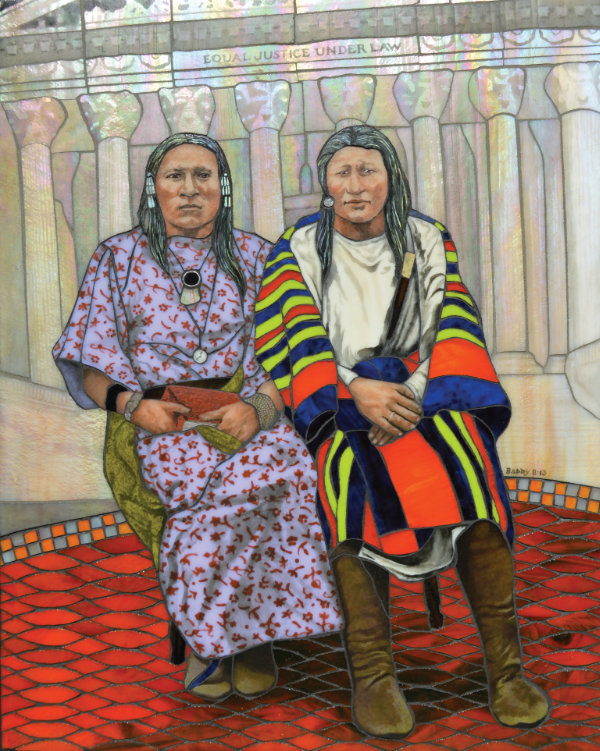
Conclusion
Native glass artists are part of a continuum of generations that have created fine art that reflects cultural knowledge and traditional designs, and their inspiration often stems from tribal lifeways. These artists take incorporated their traditions into creative expression across an e'er-evolving fix of media. While glass is non a traditional medium for Native artists, a growing number have been attracted to drinking glass, both for the backdrop inherent in working with drinking glass and the joy of working in collaboration with a community of drinking glass artists. Although glass is a relatively new medium for the creation of Indigenous art, cultural heritage remains integral to the practice. The Native artists working today in glass have, to a meaning degree, taken on the function of civilization-bearers as they atomic number 82 in the development of this relatively new form of indigenous fine art.
The artists featured in Clearly Indigenous are all established artists; some have had long careers as drinking glass artists, while others have only recently turned their artistic endeavors to the medium. These artists have melded the properties inherent in drinking glass art with their cultural knowledge to create a remarkable body of work that reflects both traditional heritage and contemporary aesthetics. The effect is a stunning presentation of idea-provoking and cute works of art.
—
After a distinguished career in federal and state authorities, as a business CEO, and as the Heard Museum CEO, Dr. Letitia Chambers returned to Santa Fe in 2012, where she has lived off and on for 50 years. She has curated major exhibits for MIAC and the Santa Atomic number 26 Botanical Garden and is the author of Clearly Ethnic: Native Visions Reimagined in Glass.
Copyright © 2022 El Palacio Magazine. Published by the New United mexican states Section of Cultural Affairs.
Source: https://www.elpalacio.org/2021/05/story-tellers-in-glass/
Post a Comment for "Northwest Native Arts Basic Forms Authentic Northwest Native Art Orca"